Table of Contents
Introduction
The goal of this guide is to teach you to feel and control your pelvis and hip muscles so that you can better use and control your pelvis in a variety of yoga poses to make those yoga pose easier, more stable, and more mindful.
The idea is to help you get better at driving your own body. And so you could think of this as “driving lessons for you and your body” (as opposed to driving lessons for learning to drive a car.)
Obviously you have some control of your body already. This guide takes you further.
As an example, just because you know how to drive a car doesn’t mean you can automatically get on a motorbike and ride it. I tried and failed dismally, wrecking a bike in the process.
So now imagine your body like a motorbike, that you have to use your whole body (not just hands and feet) to help control it. And you have to balance it as well. Or imagine your body has become the equivalent of a formula one race car. And now you have to learn how to drive it. This guide shows you how.
The hip control guide is designed to help you get more familiar with your body so that you can get closer to its full potential. Better yet, it shows you how to direct your effort so that you get the most bang for your buck.
Single Joint Hip Muscles
So that you aren’t overwhelmed with new information this guide keeps it simple. It focuses on single joint muscles of the hip and how to feel and control them.
What’s a single joint muscle? It’s a muscle that crosses and acts on only one joint, in this case the hip joint.
Because the muscles that we will be focused on act on only one joint it may be easier to isolate them and it may be easier to learn to feel and control them, even though some of these muscles are small and deep, meaning that in some cases you can’t see them by looking at the body. However, you can learn to feel them, or the results of their actions. And more importantly you can then consciously use them to help make doing yoga poses easier.
And that’s what this guide is for, to help you consciously feel and control the muscles of your hips.
But you won’t have to always consciously control them.
Once you’ve trained yourself in their use, you can then use them subconsciously, as the need arises. Like having learning to use the brakes, accelerator and steering wheel of a car, you can then use them without having to think.
Muscles Included
Single joint hip muscles include:
- Iliacus
- Pectineus
- Adductor Brevis, Longus and Front Portion of Adductor Magnus
- Adductor Magnus Long Head
- Obturator Externus
- Obturator Internus (and superior and inferior gemellus muscles)
- Quadratus Femoris
- Gluteus Medius
- Gluteus Minimus
While the focus is on these muscles, I’ll talk about actions that may be due to other (non-single joint) muscles when appropriate.
Making Yoga Poses Easier
In what way does using these muscles make doing yoga poses easier?
Some of them can be used to make forward bending easier. You’ll be able to use them to act directly on the pelvis to tilt it forwards.
Some of them can be used to make back bending easier. In poses like table top, reverse plank, bridge pose wheel pose and even camel, you may find it easier to push your pelvis higher (or in the case of camel pose, further forwards.)
You may find these actions handy when balancing on one leg.
Some of these actions can also be helpful in hip opening or hip stretching yoga poses.
Improving Pelvic Awareness
Because all of these muscles attach directly to the pelvis at one point or another you should find that you develop better awareness of your pelvis.
(To assist in that endeavour I’ve included some simple body awareness meditations.)
As you develop that awareness you then don’t have to focus so much on activating the muscles, instead you can focus on what you are trying to do with your pelvis, whether moving it, keeping it stable or changing its shape.
And that could be thought of as one of the big ideas of the hip control guide, developing better (and awareness) of your pelvis.
Creating a Foundation
To make controlling your hip muscles easier, it helps to understand that muscles, in order to contract, need a foundation to work from.
Since we’re mainly working with the hip joint we are either moving the pelvis relative to the thigh bone or vice versa.
- If moving the pelvis relative to the thigh then we can think of the thigh as the foundation. To make it more stable we can stabilize the knee, ankle and foot.
- If moving the leg relative to the pelvis then we can think of the pelvis as the foundation. To make it more stable we can stabilize the waist and ribcage.
In either case, we stabilize a part of the body by “locking” bones together at the joints (stabilizing the joint.)
When the thigh and lower leg are locked together, this combined unit has more mass than just the thigh. Likewise, locking the pelvis to the ribcage makes a more massive (and thus more stable) foundation than just the pelvis.
To stabilize a joint and lock together the bones that the joint connects, we add tension.
- To stabilize the knee we can use the muscles at the front of the thigh (the quadriceps) against the muscles that work on the back of the knee (the hamstrings and gastrocnemius/calf muscle.)
- To stabilize the waist we can use the abs (particularly rectus abdominus) against the spinal erectors (particularly those that work on the region of the spine from the sacrum up to the middle of the thoracic spine.)
We can also create stability by activating a muscle against gravity.
- As an example, in boat pose (in the next section), when we lean the torso back, we stabilize the mid section by activating the abs. In this case the abs are working against the weight of the ribcage and head to stabilize the waist.
The set of exercises below teaches you how to actively flex your hips (using the hip flexors) but also the difference between having the thighs move relative to the pelvis and vice versa.
Boat Pose Hip Flexing Variation
Boat pose (actually a variation of it) is one of the exercises that I use to teach “active” hip flexion. And I teach active hip flexion to make forward bending poses (hamstring stretches) easier.
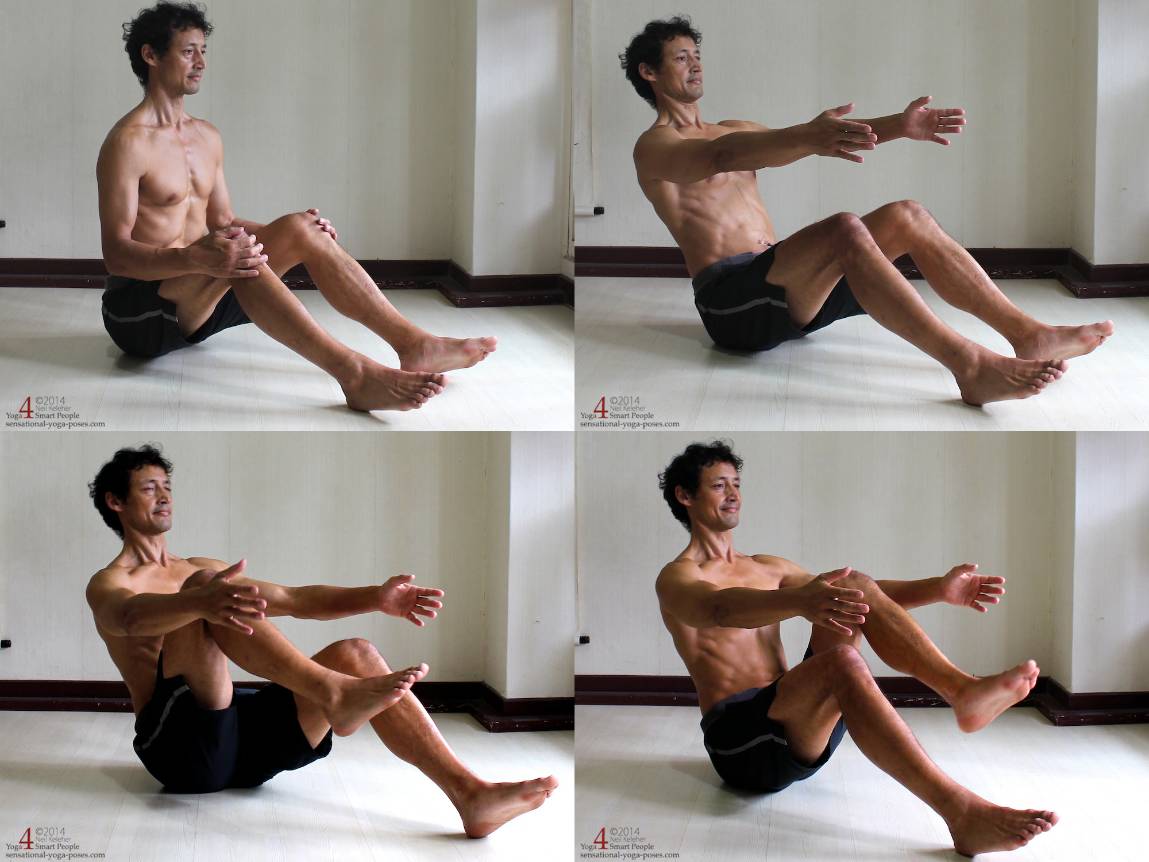
1. Sitting upright with chest lifted.
2. Leaning Back with arms reaching forward and heels on the floor.
3. Lifting one thigh.
4. Lifting the other thigh.
The first action is to lift and open the chest, moving it away from the front of the pelvis. Then lean the torso rearwards while keeping the heels on the floor.
The exercise is to pull up on one thigh so the heel comes off of the floor. Then lower the leg.
- Focus on creating an upward (and slightly rearward) pull on the thigh and/or knee that you are lifting.
- Keep the chest lifted as you lift the leg and lower it.
Repeat 4 to 8 times for each leg, changing sides each time.
Sit upright to rest and recover.
Boat Pose Hip Flexing 2
After resting for a few moments, a progression from the previous exercise is to straighten the knee after lifting the thigh.
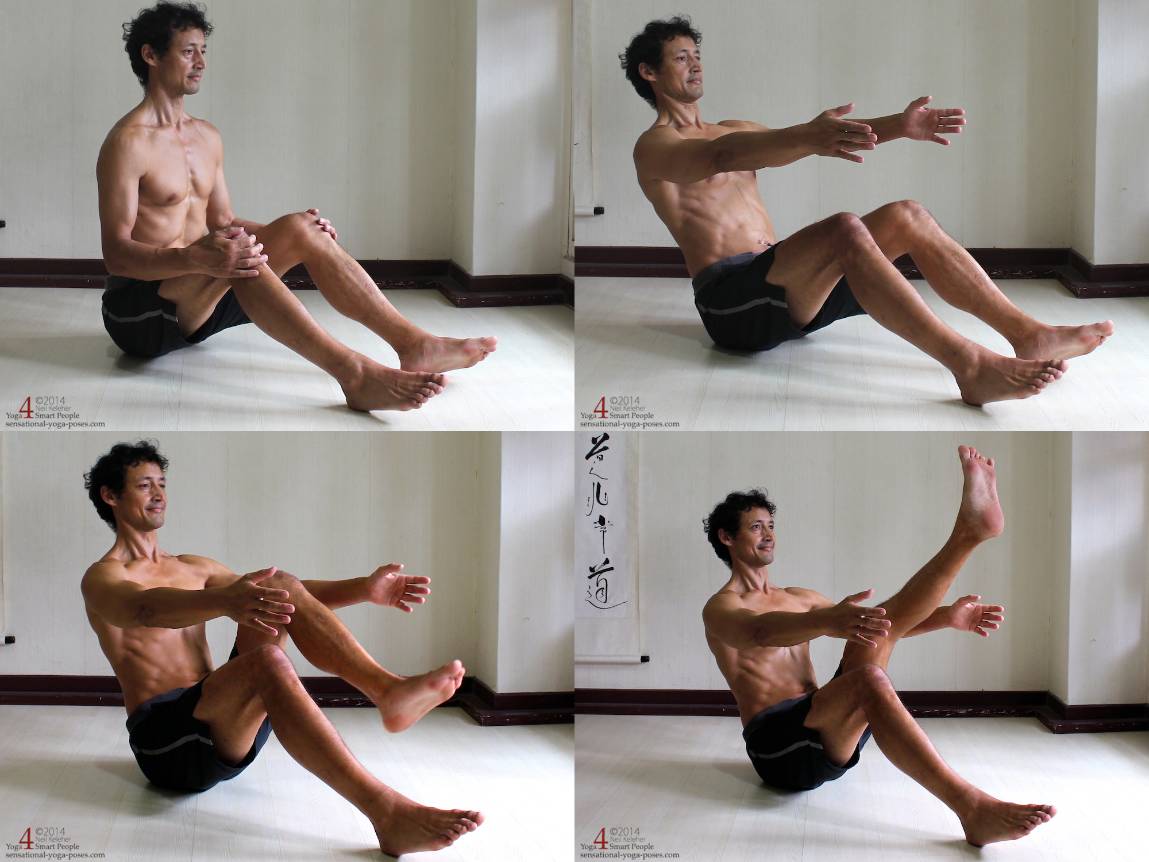
1. Sitting upright with chest lifted.
2. Leaning Back with arms reaching forward and heels on the floor.
3. Lifting one thigh.
4. Straightening the knee (thigh doesn’t move.)
As in the previous exercise, lift the chest, reach the arms forwards, then lean the torso back, keeping the heels on the floor.
Lift one thigh, then straighten the knee. Pause and then bend the knee and lower the heel to the floor.
- When straightening the knee try to maintain the position of the thigh.
- After straightening the knee try to “squeeze” the knee from all four sides.
Repeat 4 to 8 times for each leg, switching legs each time.
Seated Leg Lifts
The next progression is to do a similiar action with the torso upright.
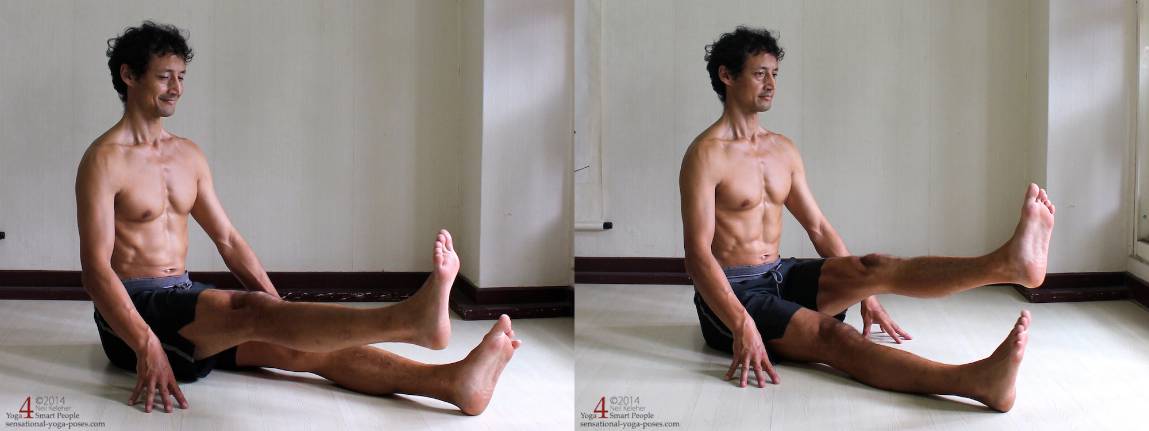
Sitting upright, lifting one thigh at a time with knee straight.
Sit upright with the knees straight and feet hip width apart. Position the hands on the floor beside your thighs.
Lift the chest (and lengthen your neck.) Keeping the knee straight pull up on one thigh. Then lower and relax. Repeat 4 to 8 times with each leg.
Rest for a few moments and then do the same action while slightly bent forwards.
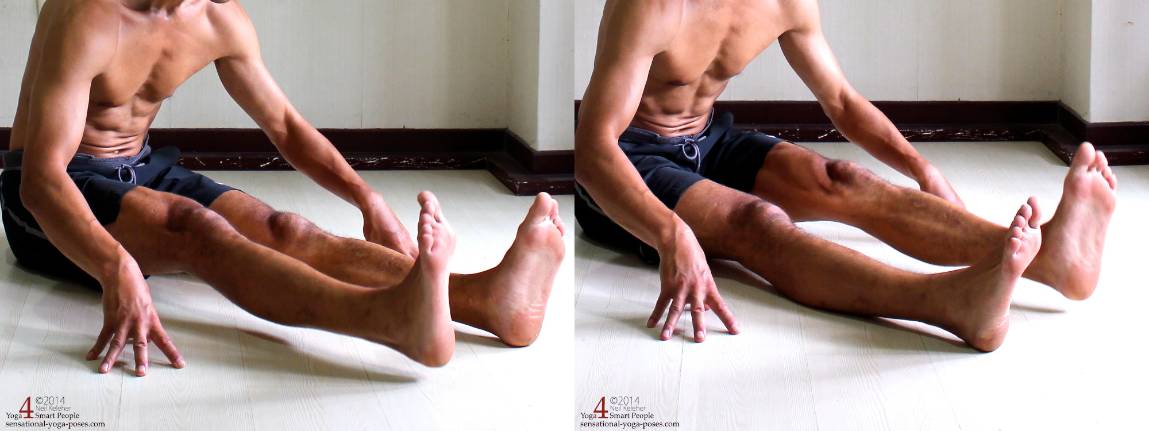
Slightly bent forwards, pulling upwards on one thigh at a time with knee straight.
If you can’t lift a leg while bent forwards, don’t worry . The more important action is that of creating an upward pull on the thigh.
Note if you do lift your leg you may find your thigh cramps. I’ve included some tips later in the hip control guide to help better recruit the hip muscles so as to help avoid cramping (which is possibly a result of not enough muscles being recuited to do the action.)
Reversing the Foundation (Seated Hip Flexion)
In the next exercise the idea is to create an upward pull on both thighs at the same time with the hands off of the floor and the arms reaching forwards.
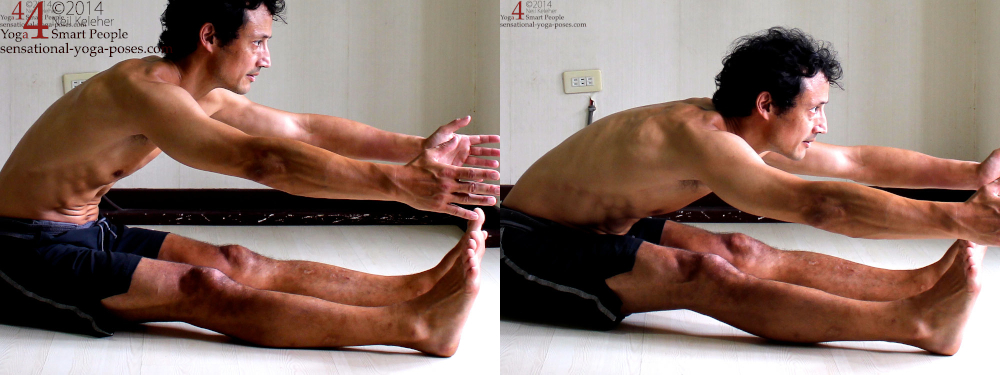
Bending forwards, lifting both thighs with knees straight and hands lifted.
Of course you won’t be able to lift the legs up (since you have no leverage.) However the feeling of the exercise is the same, with both legs being pulled up at the same time.
The previous set of exercises is mainly to teach the action of “lifting the thighs.”
Here the goal is to use the lifting action of the thighs to tilt the pelvis forwards relative to the thighs.
With feet hip width apart and knees straight bend forwards. Try to move your chest away from your pubic bone and make the sides of your neck feel long. Take your hands off of the floor and reach them forwards.
Recreate the feeling of lifting the thigh off of the floor with the knee straight but work on lifting both legs at the same time.
It’s not so much that you are trying to lift the legs. Instead think about using the same muscles that you used to lift the leg to tilt the pelvis forwards.
Table Top As a Counterpose for Hip Flexing
To rest and recover from the above set of exercises I like to use table top pose.
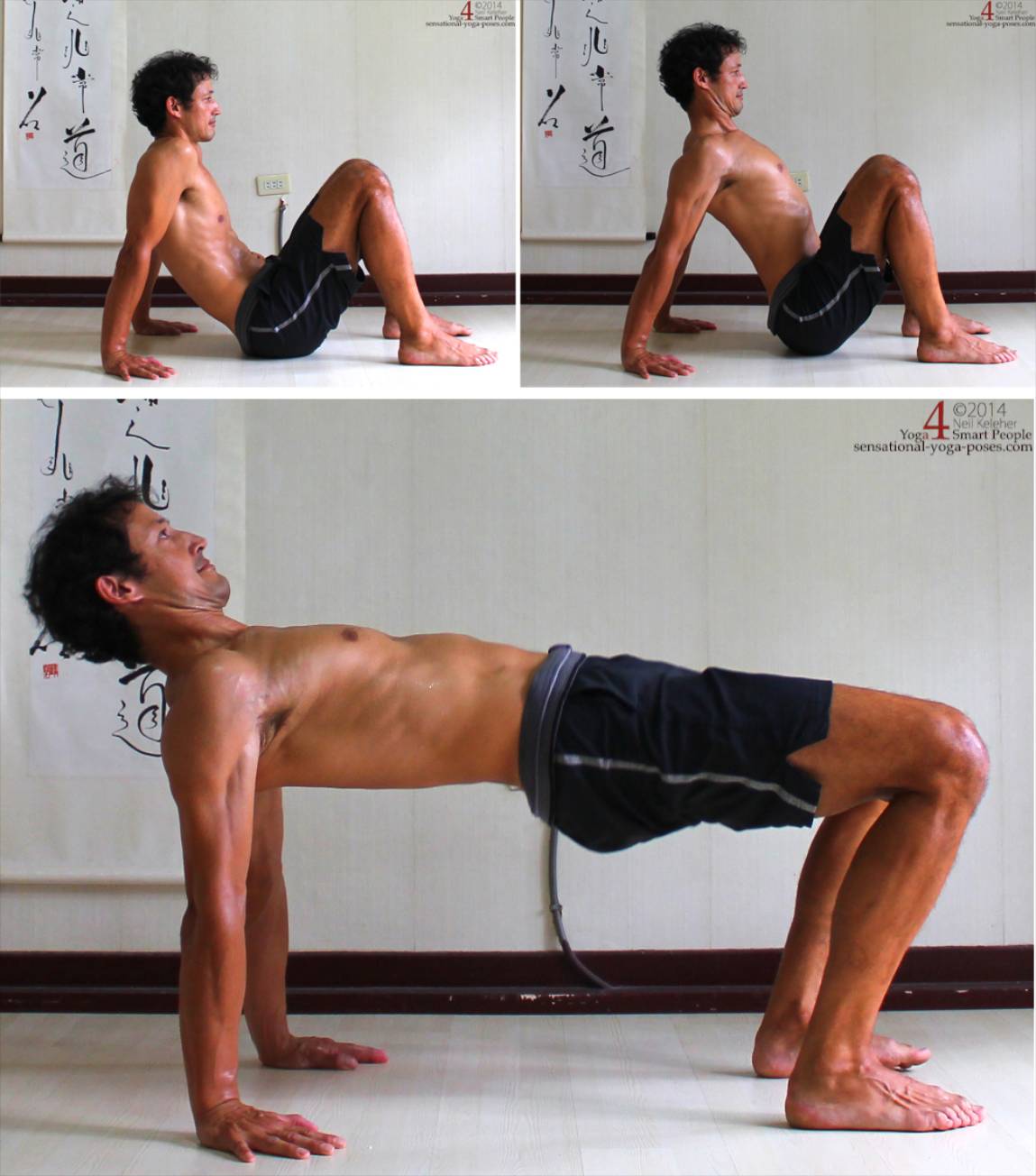
Table Top With Shoulders relaxed then active and then with hips lifted.
One way that I teach this exercise is to have my students gradually press their feet down and then relax (without lifting their pelvis.)
With respect to the arms in this pose, as you lift your pelvis higher:
- move your shoulder blades towards each other. Then
- squeeze your elbows. And additionally
- press the tips of your fingers into the floor so that your fingers feel strong.
Or, start with these arm actions before you lift your pelvis. In that case:
- first press your finger tips into the floor, then
- squeeze your elbows (make them feel strong) then
- move your shoulders back and then
- open the chest. Then
- lift your hips by pressing your feet down into the floor.
In this latter case you are stabilizing the arms so that the muscles of the shoulder have a foundation from which to help move the chest forwards relative to the shoulders. (This is when the pelvis is still on the floor.)
As you lift your pelvis higher and your torso becomes more horizontal you can focus on reaching your chest rearwards, towards your chin.
Landmarks of the Pelvis
To make controlling the hip joints easier it helps to know some landmarks of the pelvis.
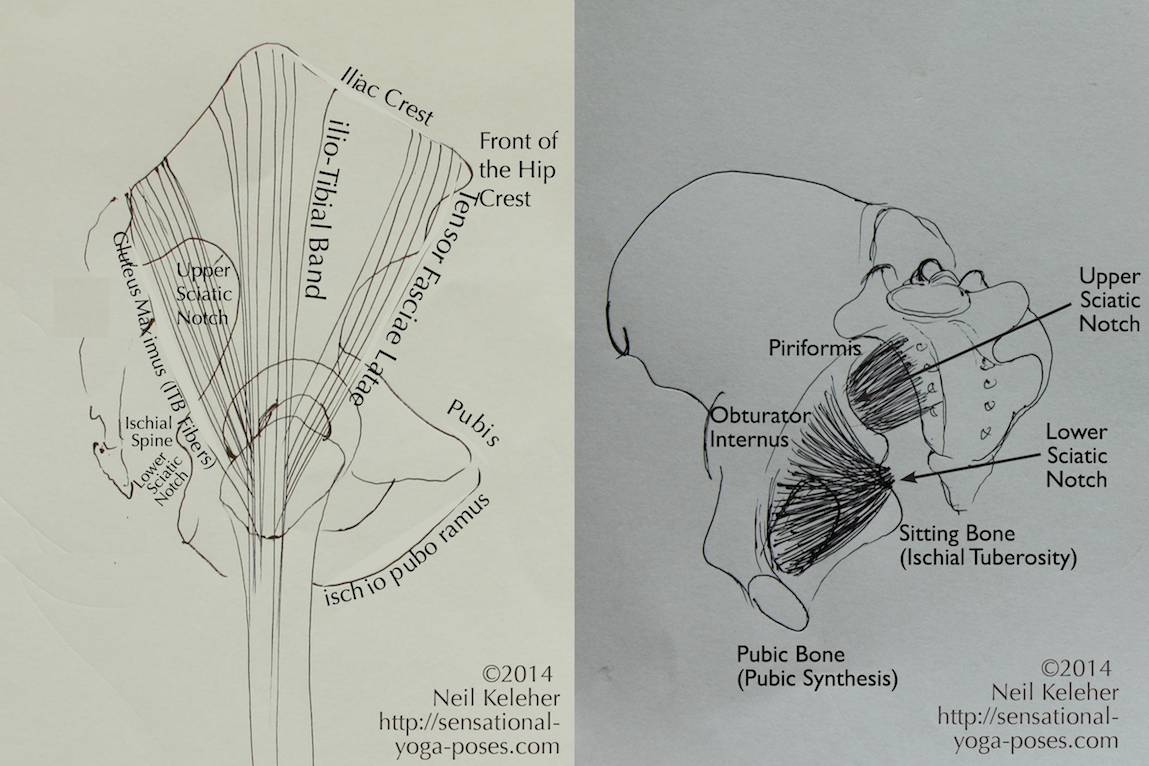
Pelvic Landmarks:
Side view (right side of pelvis) and Inside View (of right side of pelvis).
Note the tensors fascae latae muscle.
The Pubic Bone and Sitting bones are two of the easier landmarks.
- The sitting bones (ischial tuberosities) are the bones you feel when you sit down.
- The pubic bone (or pubis) is the bone at the front of your pelvis, around the location of your reproductive organs. It’s the bone at the bottom of your belly.
- The Sacrum is the triangular piece of bone that forms the base of the spine and whose tip (the tailbone) ends just behind the anus. (The tailbone acts as one end of the support for the anus.)
- The iliac crests are the crescents of bone at either side of the hip.
- The front of each Iliac Crest is called the anterior superior iliac crest (often shorted to ASICs.) I often refer to these points as the front of the hip bones.
Seated Spinal Awareness Exercise
I often use the sacrum as a reference when teaching a simple action like bending the lumbar spine backwards.
As an example, while seated (in a chair is fine, or you can be cross legged or kneeling) slowly lift your sacrum. Then allow it to lower. Repeat this a few times while focusing on feeling your sacrum.

Practicing pelvic and Spinal Awareness while in a chair, kneeling and sitting cross legged. The top row shows a relaxed or “bent forwards” spinal position.
The bottom row shows a backwards bending spine with the pelvis rolled forwards (so that sacrum is lifted.)
Continue the same action and then bring your focus to your lumbar spine. As you lift your sacrum feel your lumbar spine bending backwards. Relax the back bend as you lower your sacrum.
Continue on with the same action but carry the back bend up into the thoracic spine.
As you lift your sacrum bend your lumbar spine backwards (you may feel your erector spinae muscles activating along either side of the spine) and then bend your thoracic spine (the back of your ribcage) backwards also.
The Upper and Lower Thoracic Spine
To make bending the thoracic spine backwards easier, divide the ribcage into a lower half (corresponding to the costal arch at the front of the ribcage) and an upper half (the part which attaches to the sternum.)
First focus on bending the lower half backwards. Then once you have a feel for the lower half then add the upper half.
Breath-Like Movements
You could imagine that the above movement is like your breath. The smoother and slower you move the slower and smoother your breath will be.
To emphasize the breath-like aspect of this simple movement bring your awareness to the front of your body. As you bend your spine backwards expand your ribcage (move the ribs away from each other) and lift your ribs (move the ribs upwards, away from your pelvis.)
As you relax, let your ribcage sink down.
Repeat this a few times. If you do it slowly and smoothly enough it can feel quite nice.
Adding Pelvic Awareness
Continuing the above exercise, next move your awareness to your pubic bone. As you lift your sacrum feel the way your pubic bone moves down (and perhaps slightly backwards.)
Focus on feeling your sacrum and pubic bone as you rock your pelvis.
Next focus on the sitting bones. As you lift your sacrum feel your sitting bones move back and up. Feel them move in the opposite direction as you lower your sacrum.
Then focus on the fronts of the hip bones. As you lift your sacrum feel these points moving downwards. As you lower your sacrum feel them moving upwards.
More Pelvic Landmarks
The sacrum is the downward pointing triangular piece of bone that forms the bottom of the spine and connects the two halves of the pelvis at the rear. (The pubic bone joins the two halves of the pelvis at the front.)

Pelvic Landmarks:
Note the ischio pubo ramus and ischial spines, marked in the image to the left and the upper and lower sciatic notches marked in both the image to the left and right. Also note how the piriformis passes through the upper sciatic notch above the ischial spine and how the obturator internus wraps around the back of the pelvis at the lower sciatic notch.
- The tailbone forms the bottom point of the sacrum. To either side of the tailbone, and slightly lower than the bottom point of the tail bone are the two sitting bones, which I’ve already mentioned.
- The ischiopuboramus are two rocker-like shaped bones that run from the sitting bones to the pubic bone. If you palpate or feel your sitting bones, you may be able to run your hands forwards and feel a continuous ridge of bone that connects your sitting bone to the pubic bone (one of each side.) That’s the ischiopuboramus (on one side.)
- Moving upwards from the sitting bones, at about the level of the bottom of the tailbone are the ischial spines. These little spikes of bone stick inwards and help to define two concave cut outs at the rear edge of the pelvis:
- Just below the ischial spine is a slight cutout called the inferior sciatic notch.
- Just above the ischial spine is a half moon shaped notch called the superior sciatic notch.
- Note the opening or hole at the bottom of each side of the pelvis, between the ischiopuboramus and the hip socket. These openings are called the obturator foramen.
Mapping the Pelvis
Take the time to palpitate your pubic bone, your sitting bones, your sacrum and your hip crests.
Next put your awareness on your pubic bone. Feel it with your minds eye. From there move your awareness backwards from there along each of the ischiopuboramii (the rockers of the pelvis) to the sitting bones.
From the sitting bones move your awareness upwards to about the level of the bottom of the tailbone. Imagine the ischial spines sticking slightly inwards just above the bottom of the sitting bones.
From there you could move your awareness upwards, imagining the superior sciatic notch, and just above that the roughly L-shaped (or ear shaped) surface where the sacrum attaches to each side of the pelvis. Move upwards from here to the rear of the iliac crest. See if you can trace the top of the iliac crest with your minds eye.
Travel to the front of each crest, then move your awareness downwards and inwards, back to the pubic bone.
If you like, take the visualization a little further. Draw a line around the inside of the pelvis from the top of the sacrum at the rear to the top of the pubic bone at the front. This is the arcuate line.
Just below the arcuate line, near the front of the pelvis, imagine the two openings, the obturator foramen on either side of the pelvis, between the arcuate line and the bottom of the ischio pubo ramii.
Landmarks of the Thigh Bone
Moving on to the thigh bone.

Landmarks of the thighbone include the Greater Trochanter and Lesser Trochanter.
- The greater trochanter marks the top of the shaft of the thigh bone. It is the bit you can feel sticking out at the side of your thigh
- To the inside of the thigh bone, just below the greater trochanter, is the lesser trochanter.
- Also important is the neck of the thigh bone. It angles upwards and forwards from the shaft of the thigh bone (femur) to attach to the ball of the hip joint.
Mapping the Upper Thigh bone
Hip control will be easier if you take the time to visualize the landmarks of the pelvis and thigh bone on your own body.
As a starter, feel the greater trochanter with your hand. Then put your awareness there (and take the hand away.) move your awareness slightly inwards to the inner surface of the thigh bone.
Then move your awareness to the back of the inner surface of the thigh bone, just below the neck, and imagine the location of the lesser trochanter.
Note that the lesser trochanter is at about the same height as the bottom of the sitting bones.
Next see if you can visualize the neck of the thigh bone. From the greater trochanter it angles upwards, inwards (towards the pelvis) and slightly forwards. Imagine the bulk of the ball of the hip socket. Imagine the ball of the hip socket about three inches inwards from the outer surface of the thigh.

